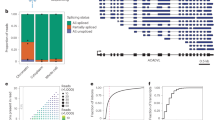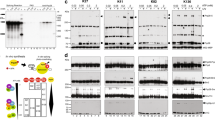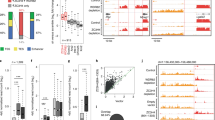Abstract
The spliceosome is thought to undergo a conformational change between the two catalytic steps of precursor messenger RNA splicing, although the specific events in this transition are poorly understood. We previously proposed a two-state model of splicing in which the conformations required for the first and second steps are in competition. Here, we identify and characterize a class of prp8 mutants that suppress first-step splicing defects and oppose the action of the previously described prp8 suppressors of second-step defects; these opposing effects parallel those of ribosomal 'ram' and 'restrictive' mutants, which alter fidelity of transfer RNA decoding. On the basis of genetic interactions, we propose that prp8-mediated substrate repositioning during the transition occurs between catalytic-center opening and closure mediated by the U6 small nuclear RNA and the DExH/D ATPase gene prp16. Modulation of these events alters splice-site selection and splicing fidelity.
This is a preview of subscription content, access via your institution
Access options
Subscribe to this journal
Receive 12 print issues and online access
$189.00 per year
only $15.75 per issue
Buy this article
- Purchase on Springer Link
- Instant access to full article PDF
Prices may be subject to local taxes which are calculated during checkout






Similar content being viewed by others
References
Burge, C.B., Tuschl, T.H. & Sharp, P.A. Splicing of precursors to mRNAs by the spliceosomes. in The RNA World second edn. (eds. Gesteland, R.F., Cech, T.R. & Atkins, J.F.) 525–560 (Cold Spring Harbor Laboratory Press, Cold Spring Harbor, New York, 1999).
Jurica, M.S. & Moore, M.J. Pre-mRNA splicing: awash in a sea of proteins. Mol. Cell 12, 5–14 (2003).
Nilsen, T.W. RNA-RNA interactions in nuclear pre-mRNA splicing. in RNA Structure and Function (eds. Simons, R.W. & Grunberg-Manago, M.) 279–307 (Cold Spring Harbor Laboratory Press, Cold Spring Harbor, New York, 1998).
Staley, J.P. & Guthrie, C. Mechanical devices of the spliceosome: motors, clocks, springs, and things. Cell 92, 315–326 (1998).
Grainger, R.J. & Beggs, J.D. Prp8 protein: at the heart of the spliceosome. RNA 11, 533–557 (2005).
Query, C.C. & Konarska, M.M. Suppression of multiple substrate mutations by spliceosomal prp8 alleles suggests functional correlations with ribosomal ambiguity mutants. Mol. Cell 14, 343–354 (2004).
Schneider, S., Campodonico, E. & Schwer, B. Motifs IV and V in the DEAH box splicing factor Prp22 are important for RNA unwinding, and helicase-defective Prp22 mutants are suppressed by Prp8. J. Biol. Chem. 279, 8617–8626 (2004).
Umen, J.G. & Guthrie, C. A novel role for a U5 snRNP protein in 3′ splice site selection. Genes Dev. 9, 855–868 (1995).
Ben-Yehuda, S., Russell, C.S., Dix, I., Beggs, J.D. & Kupiec, M. Extensive genetic interactions between PRP8 and PRP17/CDC40, two yeast genes involved in pre-mRNA splicing and cell cycle progression. Genetics 154, 61–71 (2000).
Siatecka, M., Reyes, J.L. & Konarska, M.M. Functional interactions of Prp8 with both splice sites at the spliceosomal catalytic center. Genes Dev. 13, 1983–1993 (1999).
Lesser, C.F. & Guthrie, C. Mutational analysis of pre-mRNA splicing in Saccharomyces cerevisiae using a sensitive new reporter gene, CUP1. Genetics 133, 851–863 (1993).
Burgess, S.M. & Guthrie, C. A mechanism to enhance mRNA splicing fidelity: the RNA-dependent ATPase Prp16 governs usage of a discard pathway for aberrant lariat intermediates. Cell 73, 1377–1391 (1993).
Collins, C.A. & Guthrie, C. Allele-specific genetic interactions between Prp8 and RNA active site residues suggest a function for Prp8 at the catalytic core of the spliceosome. Genes Dev. 13, 1970–1982 (1999).
McPheeters, D.S. Interactions of the yeast U6 RNA with the pre-mRNA branch site. RNA 2, 1110–1123 (1996).
Konarska, M.M., Vilardell, J. & Query, C.C. Repositioning of the reaction intermediate within the catalytic center of the spliceosome. Mol. Cell 21, 543–553 (2006).
Villa, T. & Guthrie, C. The Isy1p component of the NineTeen complex interacts with the ATPase Prp16p to regulate the fidelity of pre-mRNA splicing. Genes Dev. 19, 1894–1904 (2005).
Ogle, J.M., Carter, A.P. & Ramakrishnan, V. Insights into the decoding mechanism from recent ribosome structures. Trends Biochem. Sci. 28, 259–266 (2003).
Kurland, C.G., Hughes, D. & Ehrenberg, M. Limitations of translational accuracy. in E. coli and S. typhimurium: Cellular and Molecular Biology Vol. 1 (eds. Neidhardt, F.C. et al.) 979–1004 (ASM Press, Washington, DC, 1996).
Piepersberg, W., Noseda, V. & Bock, A. Bacterial ribosomes with two ambiguity mutations: effects of translational fidelity, on the response to aminoglycosides and on the rate of protein synthesis. Mol. Gen. Genet. 171, 23–34 (1979).
Rosset, R. & Gorini, L. A ribosomal ambiguity mutation. J. Mol. Biol. 39, 95–112 (1969).
Umen, J.G. & Guthrie, C. Mutagenesis of the yeast gene PRP8 reveals domains governing the specificity and fidelity of 3′ splice site selection. Genetics 143, 723–739 (1996).
Schwer, B. & Guthrie, C. PRP16 is an RNA-dependent ATPase that interacts transiently with the spliceosome. Nature 349, 494–499 (1991).
Mayas, R.M., Maita, H. & Staley, J.P. Exon ligation is proofread by the DExD/H-box ATPase Prp22p. Nat. Struct. Mol. Biol. 13, 482–490 (2006).
Schwer, B. & Gross, C.H. Prp22, a DExH-box RNA helicase, plays two distinct roles in yeast pre-mRNA splicing. EMBO J. 17, 2086–2094 (1998).
Wagner, J.D., Jankowsky, E., Company, M., Pyle, A.M. & Abelson, J.N. The DEAH-box protein PRP22 is an ATPase that mediates ATP-dependent mRNA release from the spliceosome and unwinds RNA duplexes. EMBO J. 17, 2926–2937 (1998).
Umen, J.G. & Guthrie, C. Prp16p, Slu7p, and Prp8p interact with the 3′ splice site in two distinct stages during the second catalytic step of pre-mRNA splicing. RNA 1, 584–597 (1995).
Bellare, P., Kutach, A.K., Rines, A.K., Guthrie, C. & Sontheimer, E.J. Ubiquitin binding by a variant Jab1/MPN domain in the essential pre-mRNA splicing factor Prp8p. RNA 12, 292–302 (2006).
Pena, V., Liu, S., Bujnicki, J.M., Lührmann, R. & Wahl, M.C. Structure of a multipartite protein-protein interaction domain in splicing factor prp8 and its link to retinitis pigmentosa. Mol. Cell 25, 615–624 (2007).
Reyes, J.L., Gustafson, E.H., Luo, H.R., Moore, M.J. & Konarska, M.M. The C-terminal region of hPrp8 interacts with the conserved GU dinucleotide at the 5′ splice site. RNA 5, 167–179 (1999).
Acknowledgements
We thank B. Schwer (Weill Cornell Medical College) for prp16 and prp22 mutant plasmids, C. Guthrie (University of California, San Francisco) for prp8-101 plasmid, D. McPheeters (Case Western Reserve University) for U6-U57 mutant plasmids, and D. Smith, J. Warner and members of our laboratories for helpful discussions and critical readings of the manuscript. This work was supported by US National Institutes of Health grants GM49044 to M.M.K. and GM57829 to C.C.Q., and by a Cancer Center Support (core) grant from the National Cancer Institute to Albert Einstein College of Medicine.
Author information
Authors and Affiliations
Corresponding authors
Ethics declarations
Competing interests
The authors declare no competing financial interests.
Rights and permissions
About this article
Cite this article
Liu, L., Query, C. & Konarska, M. Opposing classes of prp8 alleles modulate the transition between the catalytic steps of pre-mRNA splicing. Nat Struct Mol Biol 14, 519–526 (2007). https://doi.org/10.1038/nsmb1240
Received:
Accepted:
Published:
Issue Date:
DOI: https://doi.org/10.1038/nsmb1240
This article is cited by
-
Cryo-electron microscopy snapshots of the spliceosome: structural insights into a dynamic ribonucleoprotein machine
Nature Structural & Molecular Biology (2017)
-
PRPF8 defects cause missplicing in myeloid malignancies
Leukemia (2015)
-
The architecture of the spliceosomal U4/U6.U5 tri-snRNP
Nature (2015)
-
Diverse mechanisms for spliceosome-mediated 3′ end processing of telomerase RNA
Nature Communications (2015)
-
A conformational switch in PRP8 mediates metal ion coordination that promotes pre-mRNA exon ligation
Nature Structural & Molecular Biology (2013)



